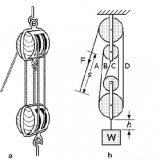Specialized Mechanisms – SIMPLE RATCHET 51027
A ratchet is a mechanical device that allows continuous linear or rotary motion in only one direction while preventing motion in the opposite direction. Though something of a misnomer, “ratchet” is also often used to refer to ratcheting socket wrenches, a common tool with a ratcheting handle.
A ratchet consists of a round gear or linear rack with teeth, and a pivoting, springloaded finger called a pawl that engages the teeth. The teeth are uniform but asymmetrical, with each tooth having a moderate slope on one edge and a much steeper slope on the other edge.
When the teeth are moving in the unrestricted direction, the pawl easily slides up and over the gently sloped edges of the teeth, with a spring forcing it (often with an audible ‘click’) into the depression between the teeth as it passes the tip of each tooth. When the teeth move in the opposite (backward) direction, however, the pawl will catch against the steeply sloped edge of the first tooth it encounters, thereby locking it against the tooth and preventing any further motion in that direction.
DETAILS OF RATCHET MECHANISM
Download This PDF: Ratchet-Mechanism.pdf
ALTERNATIVE DESIGNS – Ratchet Mechanism 1
The ratchet wheel has internal teeth.
BICYCLE FREE – WHEEL – Ratchet Mechanism 2
The blue sprocket receives motion from the pedaling bicyclist. The yellow hub rotates only when the sprocket rotates clockwise. Clockwise rotation of the yellow hub has no inflection to the blue sprocket. The red pawl is always pressed toward the sprocket’s teeth by a spring. In reality two pawls are used.
Inventor files of this video are available at:
51027_Ratchet_Mechanism_Freewheel.zip
Video Links
Featured Video – http://youtu.be/_k7JzvFg88g
Design 1 – http://youtu.be/vW6PuvflUrM
Design 2 – http://youtu.be/bAL_nWjuhOI




